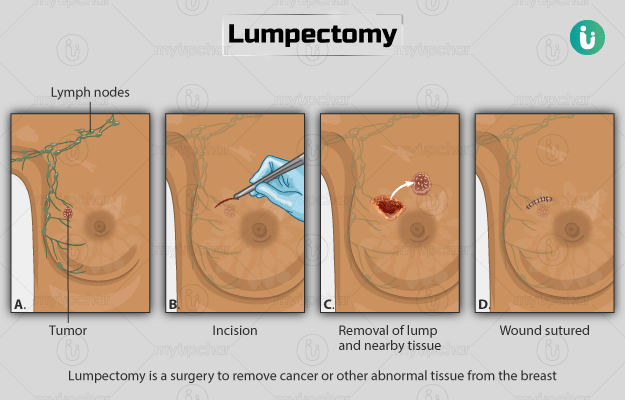Summary
Lumpectomy is a surgical procedure that is done to treat breast cancer in its early stages. The procedure is most commonly done in women but it is also done in men (less commonly) with breast cancer. In this technique, only the cancerous cells are removed without removing the entire breast. However, lumpectomy is contraindicated in many instances like early pregnancy or if your cancer has spread. Before the surgery, you will have to undergo a variety of tests, including a chest X-ray and mammogram. The surgery takes about an hour. During the procedure, the doctor will make a cut on your affected breast, remove the tumour, and stitch the breast back up. You will be discharged on the same day or the next day. After the procedure, you may need to wear a sports bra or supportive bra for a while to prevent any pain due to movement. Follow-up is generally scheduled in one to two weeks after the surgery.
- What is lumpectomy?
- Why is lumpectomy recommended?
- Who can and cannot get lumpectomy?
- What preparations are needed before lumpectomy?
- How is lumpectomy done?
- How to care for yourself after lumpectomy?
- What are the possible complications/risks of lumpectomy?
- When to follow up with your doctor after a lumpectomy?
What is lumpectomy?
Lumpectomy is a surgical technique to remove cancerous lumps in breast. It is also known as breast-conserving surgery, segmental resection, wide local excision, or partial mastectomy. During the surgery, one incision (cut) is made on the affected breast to remove the lump and a second cut is made in the armpit (axilla) to perform a biopsy (a procedure to remove a piece of tissue to examine it in a laboratory) of the lymph nodes or to remove them. Along with the cancerous tissue, some additional tissue from the surrounding area is also removed, known as a surgical margin. The sensation in the breast remains intact after the surgery.
Lumpectomy is typically done in women with breast cancer. In men with breast cancer, a mastectomy is generally performed. This is because most breast cancers in men are situated behind the nipple and grow into it, In case a lumpectomy is done in men, radiation therapy is usually needed after it.
Why is lumpectomy recommended?
Lumpectomy is recommended in women with:
- Early-stage breast cancer such as stage I, stage II, and ductal carcinoma in situ
- Non-cancerous tumours like fibroadenoma
Some women with breast cancer may not show any symptoms, or they can show signs like:
- Irritation or dimpling of the breast skin
- Lump in the breast or armpit
- Redness or scaling of skin in breast
- Swelling in breast
- Breast pain
- Pain in the nipple area
- Change in the size and shape of the affected breast
- Nipple discharge
Non-cancerous tumours show symptoms similar to breast cancer, but need proper testing to rule out the cause.
Who can and cannot get lumpectomy?
Lumpectomy is contraindicated in the following conditions:
- Early pregnancy
- Tumour present in more than one location in the breast
- Recurrent cancer at the margin of the tissue that was previously removed during surgery
- Inflammatory breast cancer
- Microcalcifications (small calcium deposits in the breast that may or may not be cancerous)
- If you have had radiation therapy due to breast cancer in the same breast
- Any genetic factors that may cause a second breast cancer
- Any severe conditions like lupus or scleroderma that may increase your sensitivity to radiation therapy side effects
What preparations are needed before lumpectomy?
The following preparations are required for a lumpectomy:
- The doctor will take your overall medical history and perform a physical examination.
- You will need these tests before the surgery:
- Electrocardiogram
- Chest X-ray
- Blood tests to check the functioning of your liver and kidney
- Biopsy of the breast tissue
- Mammography (uses X-rays to examine the affected breast for diagnosis and screening)
- Ultrasound
- Magnetic resonance imaging (MRI)
- In your pre-surgical assessment, your healthcare provider will also check your weight, pulse, blood pressure, and temperature.
- Avoid smoking a few weeks before the procedure. This will help you heal quickly after the surgery.
- Discuss with your doctor all the medicines that you take. He/she will ask you to discontinue anticoagulant drugs like warfarin, aspirin, clopidogrel, and ibuprofen before the surgery.
- Tell your doctor if you have any allergies or are pregnant.
- You will need to stop eating at least six hours before the lumpectomy, but you may be allowed to drink clear liquids until two hours before.
- You will be asked to sign a form to give consent for the surgery.
How is lumpectomy done?
Before the surgery, you will be asked to to wear a hospital gown and a pair of surgical stockings. A surgeon or nurse may use a felt-tip pen to mark the area on your breast where he/she will make the incision. If your tumour is not felt, then a mammogram or an ultrasound will be performed to find the position of the tumour and make the marking.
You will then be taken to the operation theatre, and an anesthetist will adminster you either a general (a sleep-inducing medicine) or local anaesthesia (numbs the area, but you will be awake) through an intravenous (IV) line in your arm or hand. If required, a nurse may shave your chest area.
The surgery generally takes about an hour and is performed in the following manner:
- The surgeon will make a cut on the marked area on your breast.
- He/she will remove the cancerour tissue along with some of the healthy breast tissue surrounding it.
- An X-ray of the extracted sample will then be taken and sent to the pathology laboratory for testing. It is considered a clear margin if cancerous tissue is not found on the edge of the tissue.
- The surgeon will also remove the lymph nodes (structures that are part of the immune system) present in your axilla and send them to the pathology to determine the spread of cancer there.
- He/she will use metal clips to mark the region that was removed. These will act as a guide in the future to know the position of the lumpectomy and to help in targeting any radiation therapy if it is required.
- Finally, the surgeon will close your skin using sutures and cover it with a dressing.
- He/she may insert a drain in the operated site (if required) to collect any fluid that may build up in the area.
Once the surgery gets over, you will be moved to the recovery room. Your healthcare team will keep you under observation and check your temperature, blood pressure, and heart rate.
If your lymph nodes were not removed, you would get discharged on the same day, but if they are removed, you might need to stay overnight in the hospital before you get discharged.
Along with lumpectomy, you may need additional therapy such as radiation therapy, chemotherapy, or hormone therapy to reduce the chances of spread or recurrence of the cancer.
How to care for yourself after lumpectomy?
The following care may be needed once you go home after a lumpectomy:
- For the first few days, you should rest so that you can recover and resume your normal routine.
- You may need medication for any pain and discomfort you feel in the operated breast and armpit area.
- Your surgeon will advise you certain exercises to prevent stiffness in your shoulder and arm on the side of the surgery. You can start these on the morning of the day after the surgery.
- Try to sleep on the non-operated side, and use a pillow for support.
- Your doctor may suggest you to wear a sports bra or good supportive bra for a while after the procedure to prevent any movement that may cause any pain.
- Avoid taking a shower until your follow-up visit. You can use a sponge bath.
- You may need to change the dressings frequently. The site will take at least a week to heal.
- If you have a drain put up in the operated site, make sure to empty it a few times during the day. You may also need to make a note of the amount of fluid in the drain.
- Avoid activities like jogging or lifting heavy weights that can cause pain in the chest area for about two weeks.
- A support group or councelor may help you if you need emotional support.
- If your lymph nodes were not removed, you may resume work in about two to three days, but if your lymph nodes were removed, you might need about a week to recover before returning work.
When to see the doctor?
Visit your doctor if you notice any of the following after lumpectomy:
- Chills
- Fever
- Bleeding through the dressing
- Increased drainage, redness, pain, swelling, or warmth at the surgery site
- Swelling in arm
- Pain in the leg or chest
- Shortness of breath or cough
What are the possible complications/risks of lumpectomy?
Some of the risks of lumpectomy are as follows:
- Infection
- Bleeding
- Risks due to anaesthesia
- Poor wound healing
- Reaction to medicines
- Numbness around the incision site
- Change in appearance of the breast - dimpling, scar, change in shape
- Need for another surgery to remove extra breast tissue if cancer cells are too close to the margin of the tissue removed
- Stroke and heart attack
When to follow up with your doctor after a lumpectomy?
A follow-up visit is generally scheduled in one to two weeks after lumpectomy. During the visit, your doctor will remove the dressing and drain (if left in place), and any stitches or staples on the incision site.
Disclaimer: The above information is provided purely from an educational point of view and is in no way a substitute for medical advice by a qualified doctor.
Surgery Cost In Your City
References
- UCSan Diego Health [Internet]. University of California San Diego. California. US; Lumpectomy
- Memorial Sloan Kettering Cancer Center [Internet]. New York. US; Lumpectomy
- Niederhuber JE, Armitage JO, Doroshow JH, Kastan MB, Tepper JE, eds. Abeloff's Clinical Oncology. 5th ed. Philadelphia, PA: Elsevier Saunders; 2014:chap 23, 91.
- Hunt KK, Mittendorf EA. Diseases of the breast. In: Townsend CM Jr, Beauchamp RD, Evers BM, Mattox KL, eds. Sabiston Textbook of Surgery. 20th ed. Philadelphia, PA: Elsevier; 2017:chap 34.
- Centers for Disease Control and Prevention [Internet]. Atlanta (GA): US Department of Health and Human Services; What Are the Symptoms of Breast Cancer?
- The American Society of Breast Surgeons [Internet]. Maryland. US; Performance and Practice Guidelines for Breast-Conserving Surgery/Partial Mastectomy
- American Cancer Society [Internet]. Atlanta (GA). USA; Breast-conserving Surgery (Lumpectomy).
- Cancer Research UK [Internet]. London. UK; Preparing for surgery.
- Baylor Medicine [Internet]. Baylor College of Medicine. Texas. US; Lumpectomy















